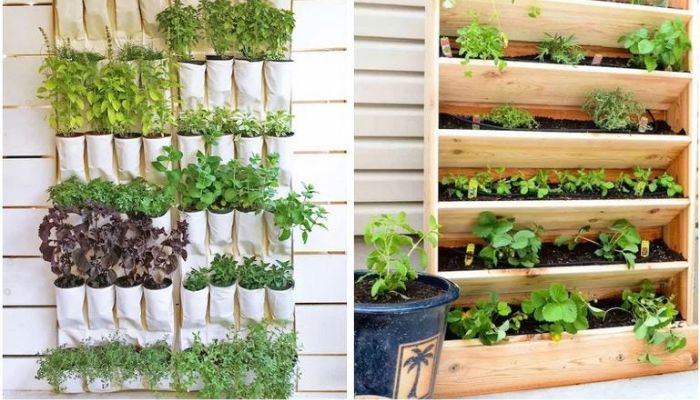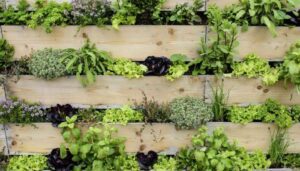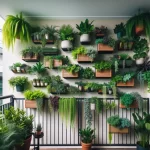I’ve been gardening in cities for over seven years and have grown plants in small spaces a lot of the time. People often ask me how to make beautiful vertical gardens with little space. After trying out different methods and layouts, I’ve learned some useful tips for making beautiful vertical gardens, even if you only have a small space. Let’s read below about “How Can I Build a Vertical Garden in a Small Space?”
I’ll show you my tried-and-true ways to build vertical gardens in small spaces like apartments, balconies, patios, and more in this blog post. I’ll give you advice that you can easily put into action based on the many projects I’ve done for clients and my own small space.
Assess Your Light Conditions
Before you start planning a vertical garden, you should figure out how much light you have. An average flower or vegetable needs at least four hours of direct sunlight daily. Thankfully, a lot of small spaces have good ambient lighting. Keep an eye on how the sun comes in during the day to see if you have enough light for plants that need it. Adaptive shade plants like begonias and impatiens do well in urban nooks that get some shade.
Choose Appropriate Plants
Choose plants that do well in a vertical position and with the amount of light you have. Ivy and creeping Jenny, which have trailing stems that fall over, make beautiful hanging gardens. It’s also good to stack bushy herbs like oregano and thyme vertically. Choose flowering plants that are short, less than one foot tall. Plants that do well in containers should be given priority since vertical gardens are basically just big pots.
Install Strong Mounting Structures
Vertical gardens need to be firmly attached to frames, walls, or fences. As the base for my vertical gardens, I often use slatted wood, metal trellises, hanging racks, and wire panels. You can safely hold these structures in place with strong brackets, anchors, poles, and hooks. I leave about 3 feet of space between my grid panels, shelves, and rails so that I can stack several groups of plants on top of each other.
Use High-Quality Soil and Containers
In vertical gardens, plants do better when they have good soil. I make my own potting mix and add worm castings and slow-release fertilizer to it so I don’t have to water and feed the plants all the time. This rich soil is what I put in my hanging pots and vertical planters to keep my plants healthy and bright. Self-watering pots and fabric grow bags with built-in water reservoirs are my favorite containers because they keep plants consistently moist between waterings.
Arrange Plants Based On Sun Exposure
Put plants that do well in both sun and shade on the parts of your vertical garden that get the most sun. When putting plants together, put the taller ones in the back and the shorter ones near the edges. For a unified look, use the most beautiful flowers over and over again in your arrangement. For interest all year, I also use evergreen vines and colorful leaves.
Provide Adequate Water and Care
Soil moisture should be checked often in vertical gardens because they dry out faster than plants planted in the ground. For easier watering, buy a drip irrigation system or a soaker hose with a timer. For targeted spot watering, I use a wand attachment to water my vertical planters by hand. Feed plants in pots once a month with balanced liquid fertilizer. To get new growth, cut back vines that are getting too big and remove the spent flowers from the stems.
Take Advantage of Vertical Space
One of the best things about vertical gardening is that it gives you more space to grow plants. You can make more room by stacking planter boxes, mounting pots on the wall, or hanging baskets at different heights. Using poles, brackets, and hanging racks, I once turned a narrow alley into a 4-level vertical garden that went all the way to the top of my fence. For the most planting space, go as high as your vertical structures will allow.
Grow Food and Herbs Too
Along with flowers for decoration, vertical gardens are great for growing plants that can be eaten. When trellised vertically, peppers, cherry tomatoes, peas, beans, and strawberries do very well. Instead of laying these crops out flat, I use grids and arching supports to save a lot of ground space. Plants that grow close together, like thyme, oregano, and chives, are easy to arrange vertically. Plan and mix edibles with annuals and perennials to make gardens that are both pretty and useful.
Take It Slow When Starting Out
If the idea of towers and multi-level layouts seems too complicated at first, try putting a few potted plants on a wall or railing that you already have. Bring it up and make it more complicated once you have the basics down. My first vertical garden was made up of just five hanging baskets that I attached to my balcony. It changed into a 40-square-foot vertical garden full of flowers and vegetables over the course of several seasons. Start small with your vertical garden and let it grow as time goes on.
Add Special Touches
Once you have the basic structure of your vertical garden set up, add unique elements to make the design stand out. I use old pots, glass bottles, reclaimed wood, and other containers that have been used before to create a fun, layered look. Add garden art, pretty vines, bright pots, or funny plant stands to make the space more interesting. Attaching containers and planting pockets to ladders, crates, and even furniture can turn them into vertical plant displays. Be yourself and show off your style.
Vertical Gardening Maximizes Growth
You can make the most of every inch of space by planting living art on fences, walls, balconies, and posts. Using vertical gardening techniques, even the smallest outdoor spaces can be turned into a lush urban oasis. You can make amazing vertical gardens even in small spaces that become the talk of the neighborhood if you have the right mounting systems, soil, and plants.
Conclusion
These tips for vertical gardening will help you make beautiful gardens that you will love for years to come. I’m here if you need anything else! I wish you the best as you go vertical to make the most of your outdoor space.
Turning small areas into lush vertical gardens is easier than you think. By using these professional tips, you can get the most out of your outdoor space and make a beautiful living wall in even the smallest space. I hope this answer to “How Can I Build a Vertical Garden in a Small Space?” helps you.

Katia Hougaard is a PhD candidate at Imperial College London, specializing in plant-aphid interactions. With a background in Plant Biology from the University of Texas at Austin, she focuses on the genetic and physiological resistance of Medicago truncatula to pea aphids. Katia has served as a science advisor for startups in vertical farming and the houseplant industry. She also mentors students and manages a research lab, contributing her expertise to both academic and entrepreneurial projects. At SuperbPlants.com, Katia shares her in-depth knowledge of plant biology, emphasizing sustainable practices and scientific integrity.






